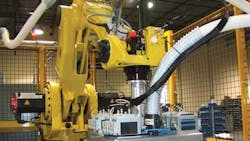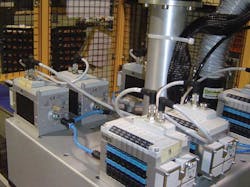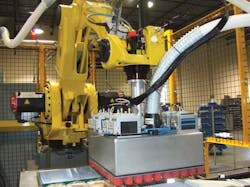This file type includes high resolution graphics and schematics when applicable.
Richmond, Va.-based AMF Bakery Systems is a leading manufacturer of high-speed bakery equipment. The company’s automated systems perform virtually every bakery task, ranging from dough mixing and make-up to baking, packaging, and case loading.
The company’s corporate goal is to develop innovative systems for automating bakery plants with a focus on quality, efficiency, and value. One obvious candidate for automation involved using robots to pick up packages of freshly baked buns and other bread products off conveyors and pack them into bread trays bound for distribution centers.
Yet the process was a production bottleneck.
The problem? Traditional robotic tooling designed for handling baked goods must be changed out for each different loading pattern or product size. This resulted in significant downtime and, in some cases, required maintenance engineers to perform the changeovers, as opposed to line operators.
In addition, available tooling required the sub-elements of the vacuum handling device to be isolated from one another. Otherwise, the tooling would secure whatever product was underneath it in the pick area. If the pick pattern were two packages of buns, for example, only two packages could be sent down the conveyor to the robot at a time. This limited production rates. The system also had constant vacuum running through the suction cups, which wasted energy.
As a result, on some lines buns had to be packed into trays by hand because the robot could not perform the necessary pick-and-place operations. Having a robotic system with the flexibility to handle all product sizes and patterns would speed production and substantially reduce manual labor.
Design objectives
To meet this goal, AMF’s engineers had several requirements for redesigned end-of-arm robotic tooling:
Cup density. The system would have a sufficient number of vacuum cups (population density) on the tooling to ensure adequate suction, stability, and holding force, regardless of the product being picked.
Individual control. Tooling required not only a highly dense vacuum-cup population, but the application demanded that each cup could be independently turned on and off. That, in turn, required a high number of individually controlled valves—one for each cup. The ability to turn on and off individual vacuum cups would let the tooling contact multiple products but only pick up the ones needed for the pack pattern. This would also allow products to be mass accumulated and not separated from the flow by pick count.
Changeover time. The system should minimize the need to change tooling because of pattern or product size. This would eliminate a lot of unnecessary downtime.
Quick response. The valve controls had to ensure quick and repeatable timing of the on and off function of each cup. This meant mounting the valves and controls on the tooling.
Size and weight. This aspect of the project presented a formidable challenge. Weight limitations of the robot were a primary concern, as was size. Because valves and controls must mount on the tooling, they had to be as light and compact as possible. Otherwise, the added weight could negatively impact robot performance or, in the worst case, require a larger and more costly robot.
Power and data. As with most any other tooling design, safe and efficient routing of vacuum supply, electrical cables, and air lines also challenged the designers.
Re-engineered tooling
To develop a new type of lightweight, end-of-arm robotic tooling with the flexibility to handle widely varying pick-and-pack patterns for buns and other bread products, AMF turned to the engineers at Festo Corp., Hauppauge, N.Y.
A basic rectangular pattern of 128 vacuum cups was deemed sufficient for handling every type of baked good the robot would encounter. The key to the desired performance, however, was individually controlling each cup.
Festo engineers began the design process by identifying a single-acting, spring-return pneumatic cylinder—the EFK—to turn on and off each vacuum cup. The EFK is a small and light polymer cylinder with an integrated mounting flange and connection. The cover cap is friction welded to the cylinder barrel to be pressure-tight. It has a stainless-steel cylinder rod and urethane piston. The EFK Series includes models with piston diameters ranging from 8 to 25 mm, with strokes from 10 to 25 mm. Maximum pressure rating is 8 bar, and temperature range is –10 to 60°C.
To control the cylinders, the designers opted for Festo CPV10 valve manifolds. The CPV has a lightweight, cubic design and permits connection of two to eight modular valves shaped like narrow-profile “slices.” The valves offer high flow capacity despite their small size.
The highly flexible CPV lets engineers specify different types of valves, with different functions, different pressure zones and ranges, and even vacuum generators into units that are preassembled and tested at the factory. The ability to combine user-specified pneumatic performance, a variety of electrical and data connections, and a wide range of mounting options means the units can be built to suit many different applications.
The compact CPV is also engineered for tight spaces, making it well suited for AMF’s handling robot. Using a specially designed stainless-steel housing, engineers installed eight separate manifolds on the end-of-arm tooling, mounting the manifolds as close as possible to the EFK cylinders to ensure fast response. Each CPV10 manifold holds eight valve slices, with two independently controlled 3/2 valves per slice, which combined control all 128 vacuum cups.
To simplify the design, only one air line supplies compressed air to the end-of-arm tooling. From there, the main supply divides into eight lines, one for each manifold. The end-of-arm tool also holds an Ethernet/IP gateway. This limits the number of communication cables that must be run down the robot arm.
The end result: The design saves energy, speeds production, and eliminates manual labor and downtime for tooling changes. Finally, a Festo CPX control platform manages the operation of the CPV10 manifolds. The CPX has an integrated controller and can function as a standalone distributed I/O system, as well as a controller for pneumatic and electric axes. It supports common fieldbus and Ethernet protocols, a range of electrical connections, and digital and analog I/O. The modular system offers a range of configuration options, integrated diagnostics, and, with an IP65/IP67 rating, is suitable for direct machine mounting.
Process upgrade
With this arrangement, all 128 vacuum cups can be individually controlled. That means the controller can direct the tooling and vacuum cups to energize only the array needed to handle a specific product. And software can adjust the gripping pattern on the fly for near-instantaneous changes.
Despite the unique requirements, collaboration between Festo and AMF engineers throughout the development, testing, and refinement process helped ensure a successful release of the first design.
The simplicity of the valve control also met AMF Bakery Systems’ expectations for minimizing complexity, easing the task of maintenance technicians who service the valves and controls.
The programmable dense-cup-population tooling has quickly become part of AMF Bakery Systems’ standard offering, and the design of the tooling and interfaces with air, vacuum, electrical power, and data has been patented.
Future enhancements under consideration will most likely simplify the electrical controls — in particular the communications link between the PLC and the tooling. The next evolution may also shift to even lighter components and a higher cup density.
John Keane III is executive product manager for packaging and automation at AMF Bakery Systems, Richmond, Va. For more information on AMF, visit www.amfbakery.com. For more information on Festo pneumatics, visit www.festo.com/us.
This file type includes high resolution graphics and schematics when applicable.
About the Author

Leaders relevant to this article:



